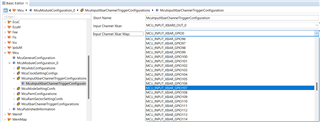Hi Team,
We have a project use-case; to trigger GPIO interrupt :
- Individual GPIO pin based Interrupt trigger (~15 GPIO ports) [we also see a limitation that the VIM supports only 4 GPIO INT per core] OR
- GPIO Bank based interrupt trigger
I found a related E2E ticket below; that talks about enabling this feature in the Bare metal environment with an example in the sdk package. However, we will need to activate this feature in the Autosar configuration environment.
Bare-Metal env arch understanding (as per the above ticket) : Bank-Based interrupt :

The GPIO interrupt is routed via INT router to VIM; which would possibly need to be configured/coded.
Autosar env arch understanding (as per MCU config options and RM diagrams) :
- There is not configuration option seen in Port or MCU module to configure the INTrouter (GPIO_XBAR_INTRTR0) module
- Would this mean that for GPIO interrupts the INT Router is not needed to be used; instead InputXBAR module needs to be used?
- MCU module provides interface for mapping GPIO to XBAR_OUT
- This mapping is not seeming to be routed to an interrupt, Rather seems to be mapping GPIO port to XBAR_OUT

- On looking through the DIO and Port modules static files; we do not observe the <module>_Irq.c files that should handle the GPIO specific ISRs
- Would this mean that the we would need to handle these GPIO interrupts as non-CAT2 ISRs (CAT0 or CAT1)?
Also, could not find any example implementations or configurations in the MCAL/examples for this concept. Could you suggest some references for achieving the project use-case.

